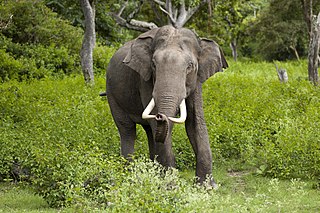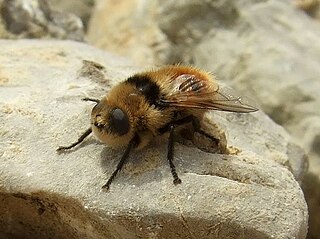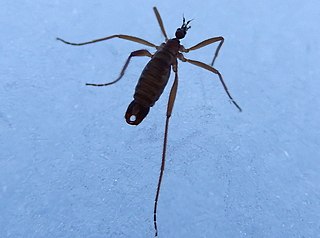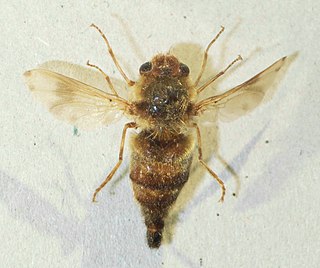
Flies are insects of the order Diptera, the name being derived from the Greek δι- di- "two", and πτερόν pteron "wing". Insects of this order use only a single pair of wings to fly, the hindwings having evolved into advanced mechanosensory organs known as halteres, which act as high-speed sensors of rotational movement and allow dipterans to perform advanced aerobatics. Diptera is a large order containing an estimated 1,000,000 species including horse-flies, crane flies, hoverflies, mosquitoes and others, although only about 125,000 species have been described.

Elephantidae is a family of large, herbivorous proboscidean mammals collectively called elephants and mammoths. These are large terrestrial mammals with a snout modified into a trunk and teeth modified into tusks. Most genera and species in the family are extinct. Only two genera, Loxodonta and Elephas, are living.

The African forest elephant is one of the two living species of African elephant. It is native to humid tropical forests in West Africa and the Congo Basin. It is the smallest of the three living elephant species, reaching a shoulder height of 2.4 m. As with other African elephants, both sexes have straight, down-pointing tusks, which begin to grow once the animals reach 1–3 years old. The forest elephant lives in highly sociable family groups of up to 20 individuals. Since they forage primarily on leaves, seeds, fruit, and tree bark, they have often been referred to as the 'megagardener of the forest'; the species is one of many that contributes significantly to maintaining the composition, diversity and structure of the Guinean Forests of West Africa and the Congolese rainforests. Seeds of various plants will go through the elephant's digestive tract and eventually pass through in the animal's droppings, thus helping to maintain the spread and biodiversity of the forests.

The Calliphoridae are a family of insects in the order Diptera, with almost 1,900 known species. The maggot larvae, often used as fishing bait, are known as gentles. The family is known to be polyphyletic, but much remains disputed regarding proper treatment of the constituent taxa, some of which are occasionally accorded family status.

Hippoboscoidea is a superfamily of the Calyptratae. The flies in this superfamily are blood-feeding obligate parasites of their hosts. Four families are often placed here:

Botflies, also known as warble flies, heel flies, and gadflies, are a family of flies known as the Oestridae. Their larvae are internal parasites of mammals, some species growing in the host's flesh and others within the gut. Dermatobia hominis is the only species of botfly known to parasitize humans routinely, though other species of flies cause myiasis in humans.

Gasterophilus, commonly known as botfly, is a genus of parasitic fly from the family Oestridae that affects different types of animals, especially horses, but it can also act on cows, sheep, and goats. A case has also been recorded in a human baby.

The apple maggot, also known as the railroad worm, is a species of fruit fly, and a pest of several types of fruits, especially apples. This species evolved about 150 years ago through a sympatric shift from the native host hawthorn to the domesticated apple species Malus domestica in the northeastern United States. This fly is believed to have been accidentally spread to the western United States from the endemic eastern United States region through contaminated apples at multiple points throughout the 20th century. The apple maggot uses Batesian mimicry as a method of defense, with coloration resembling that of the forelegs and pedipalps of a jumping spider.

African elephants are members of the genus Loxodonta comprising two living elephant species, the African bush elephant and the smaller African forest elephant. Both are social herbivores with grey skin. However, they differ in the size and colour of their tusks as well as the shape and size of their ears and skulls.
Harold Oldroyd (24 December 1913 – 3 September 1978) was a British entomologist. He specialised in the biology of flies, and wrote many books, especially popular science that helped entomology to reach a broader public. His The Natural History of Flies is considered to be the "fly Bible". Although his speciality was the Diptera, he acknowledged that they are not a popular topic: "Breeding in dung, carrion, sewage and even living flesh, flies are a subject of disgust...not to be discussed in polite society". It was Oldroyd who proposed the idea of hyphenating the names of true flies (Diptera) to distinguish them from other insects with "fly" in their names. Thus, the "house-fly", "crane-fly" and "blow-fly" would be true flies, while the "dragonfly", "scorpion fly" and so on belong to other orders. He also debunked the calculation that a single pair of house-flies, if allowed to reproduce without inhibitions could, within nine months, number 5.6×1012 individuals, enough to cover the Earth to a thickness of 14.3 m (47 ft). Oldroyd calculated that such a layer would only cover Germany, but remarked "that is still a lot of flies".

The name deer botfly refers to any species in the genus Cephenemyia, within the family Oestridae. They are large, gray-brown flies, often very accurate mimics of bumblebees. They attack chiefly the nostrils and pharyngeal cavity of members of the deer family. The larva of Cephenemyia auribarbis, infesting the stag, is called a stagworm. The genus name comes from the Greek kēphēn, meaning 'drone bee', and myia, meaning 'fly'.

A black fly or blackfly is any member of the family Simuliidae of the Culicomorpha infraorder. It is related to the Ceratopogonidae, Chironomidae, and Thaumaleidae. Over 2,200 species of black flies have been formally named, of which 15 are extinct. They are divided into two subfamilies: Parasimuliinae contains only one genus and four species; Simuliinae contains all the rest. Over 1,800 of the species belong to the genus Simulium.

Gyrostigma rhinocerontis is the largest fly species known in Africa. It is a parasite of the black rhinoceros and the white rhinoceros.

Chionea is a genus of wingless limoniid crane flies. It consists of two subgenera, the holarctic Chionea and palaearctic Sphaeconophilus. About 37 species are currently recognized in the northern hemisphere, but there are probably several undescribed species. They are commonly called snow flies.

The North African elephant is an extinct subspecies of the African bush elephant, or possibly a separate elephant species, that existed in North Africa, north of the Sahara, until it died out in Roman times. These were the famous war elephants used by Carthage in the Punic Wars, their conflict with the Roman Republic. Although the subspecies has been formally described, it has not been widely recognized by taxonomists. Other names for this animal include the North African forest elephant, Carthaginian elephant, and Atlas elephant. Originally, its natural range probably extended across North Africa and down to the present Sudanese and Eritrean coasts.
Loxodonta adaurora is an extinct species of elephant in the genus Loxodonta, that of the African elephants. Fossils of Loxodonta adaurora have only been found in Africa, where they developed in the Pliocene. L. adaurora was presumed to be the genetic antecedent of the two modern African elephant species; however, an analysis in 2009 suggested that L. africana evolved from L. atlantica. The same study concluded that Loxodonta adaurora was morphologically indistinguishable from Mammuthus subplanifrons and that these constituted the same species probably within the mammoth lineage. However, other authors have continued to consider L. adaurora a valid species of Loxodonta, with some considering it an early morph of Loxodonta exoptata.

Philornis is a genus of around 50 species of fly from Central and South America. Their larvae are subcutaneous parasites of nestling birds. They are sometimes referred to as "bot flies", though they are not related to true bot flies.

Cephenemyia trompe, also known as the reindeer nose botfly, is a species of botfly first described by Adolph Modéer in 1786. It belongs to the deer botfly genus Cephenemyia. This fly is parasitic on reindeer. It is one of two Cephenemyia species found only in Scandinavia.

Cuterebra fontinella, the mouse bot fly, is a species of New World skin bot fly in the family Oestridae. C. fontinella is typically around 1 cm (0.39 in) in length with a black and yellow color pattern. C. fontinella develops by parasitizing nutrients from its host, typically the white-footed mouse. C. fontinella has even been known to parasitize humans in rare cases. Individuals parasitized by C. fontinella will develop a large bump on the skin that is indicative of parasitization.

Gasterophilus intestinalis, also known as horse bot fly, is a species of insect of the family Oestridae, and is found worldwide. The adults, which have a bumblebee-like appearance, are prominently active in the summer. G. intestinalis is primarily a parasite of horses, mules and donkeys, rarely of other animals.



















